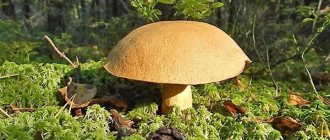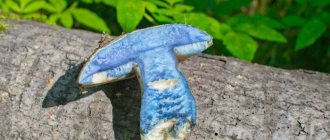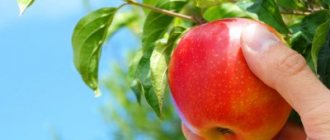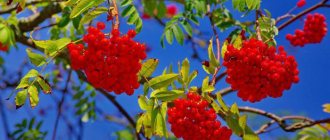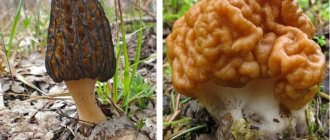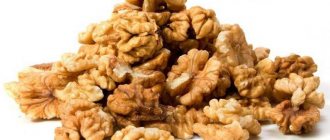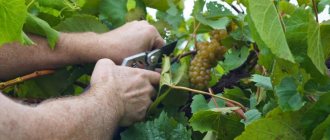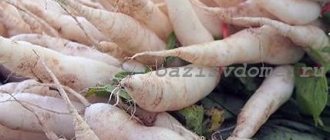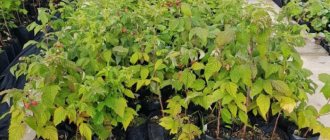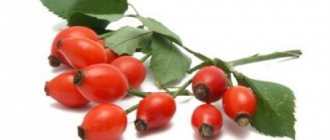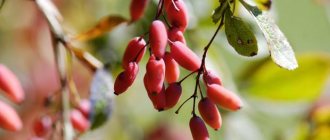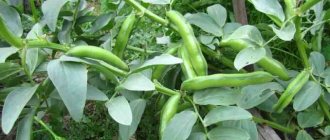Translated from Latin, openok means “bracelet”. Not surprisingly, if you look closely at the stump on which the mushrooms have sprouted, you will notice that the colony is arranged in the shape of a ring.
There are several varieties of this mushroom:
- Summer honey fungus. It grows in colonies on broken or dead wood. It has excellent taste and is grown in huge quantities.
- Autumn honey fungus. It grows both on stumps and on broken or living trees. The stem reaches 10 cm in height and 2 cm in diameter. Fruiting is gradual, occurring every 2-3 weeks.
- Winter honey fungus. The fungus is usually found on rotten willow or poplar. The leg is from 2 to 7 cm in height. The cap is 2-10 cm. Growth season is late autumn-winter.
- Meadow honey fungus. It is found mostly in ravines, forest clearings and on roadsides near roads. The leg is quite thin, up to 10 cm in height.
Description
| Parameter | Characteristic |
| hat |
|
| Skin | Mucous, darkens closer to the edges. |
| Records | Young mushrooms are beige, while old ones are almost brown. |
| Pulp |
|
| Leg |
|
How to identify and distinguish edible honey mushrooms from false ones?
- A bad honey mushroom, unlike a good mushroom, does not have a ring - a plate-shaped skirt, which is located under the cap. You can see the remains of a bedspread on the leg.
- If the mushroom is in doubt, it is better to throw it away immediately. Send mushrooms to the basket only if you are sure that they are edible, and if you have doubts or find one of the signs of a poisonous mushroom, then give up the idea of adding it to your “mushroom catch”.
What other differences exist:
- a good mushroom has a pleasant mushroom aroma, while a false one exudes an unpleasant earthy odor or no odor at all
- the cap of a bad mushroom is brightly and loudly colored, the cap of a good mushroom is an unsightly light brown color
- the caps of good mushrooms have small scales, while poisonous mushrooms have a smooth cap (however, the scales disappear over time and the caps of edible mushrooms also become smooth)
- turning over the cap of an inedible mushroom, you can see that its plates are yellow if the mushroom is young, or greenish, olive-black if the mushroom is old (the plates of good mushrooms are cream-colored or yellowish-white)
- false honey mushrooms with a bitter aftertaste, but you should not start assessing the taste of the mushroom you doubt (other, more obvious signs are sufficient)
False mushroom
For an experienced mushroom picker, it will not be difficult to distinguish a good mushroom from a bad one.
But if you are a beginner mushroom picker, then it is better to look for a skirt on the stem of the mushroom.
Dangerous Double
Summer honey mushrooms can be confused with similar mushrooms. The cost of a mistake can be different: in some cases you can end up with an inedible dish, in others - serious poisoning. The worst thing is to collect edged galerina instead of edible mushrooms.
Galerina bordered
Galerina marginata is a deadly poisonous mushroom. It contains the same poison as the toadstool (amanitin). It does not act immediately, but almost always poisoning ends tragically. It grows everywhere in coniferous forests from May until severe frosts. Galerina is not found on deciduous trees.
The red cap is up to 4-5 cm in size, conical, over time it becomes flat, with a tubercle in its center. In dry weather, the cap lightens, becoming pale yellow. There is a whitish coating on the leg.
| Parameter | Characteristic |
| At the honey mushroom |
|
| At the gallery |
|
Honey mushrooms grow in groups, and galerina grow one or 2-3 mushrooms each. A single galerina can grow among honey mushrooms, so special care is required when collecting them.
Gray honey fungus
Gray honey fungus is found in deciduous forests; the cap has a greenish tint.
Sulphur-yellow false honey fungus
This mushroom has a sulfur-yellow cap, darkening towards the center to brown. The pulp is yellow with an unpleasant odor. The leg is smooth, hollow inside, without a cuff or scales. 2-6 hours after eating, vomiting, clouding of consciousness, and sweating begin. Not fatal, but very unpleasant.
Other doubles
There are several more mushrooms similar to honey mushrooms, but noticeably poisonous, among them:
- brick-red false honey fungus is not poisonous.
- Most of the scales, which are also often confused with honey mushrooms, are edible, but look like rubber.
Video: inedible mushrooms - gray-yellow false honey fungus
- The brick-red false honey fungus is especially dangerous. It can be found on dead wood, on a rotten stump, and can also grow on flat terrain. The mushroom has a spherical cap, by which it is easy to “calculate” during mushroom harvesting. The cap has flakes hanging down the edges. The mushroom has no smell.
- All false honey mushrooms differ in the shades of the internal plates located under the cap. They can range from dark to sulfur-yellow or black-olive. Plates of good cream-colored mushrooms. False honey mushrooms grow in large groups.
False honey fungus sulfur-yellow
Where and when do summer mushrooms grow?
Summer honey mushrooms grow in damp deciduous or mixed forests. Their favorite places are rotten stumps, rotten wood, clearings near lakes, and in mountainous areas they can be found on coniferous trees. The harvest is abundant and friendly.
This honey fungus is also called linden, since it is most often found on linden trees. You can often find huge colonies of up to hundreds of mushrooms clinging to an old stump.
When searching for summer mushrooms, you should not limit yourself to only stumps; they can also be found next to some bushes, in meadows and forest edges.
They are found in temperate and warm latitudes almost everywhere, except in permafrost. In the south they can bear fruit all year round, and in more northern areas from April-May to October. The height of the mushroom harvest covers mid-July and all of August.
Video: Mushroom poisoning! Symptoms and first aid!
First aid is as follows:
- it is necessary to avoid dehydration and help get rid of the symptoms of poisoning; induce vomiting after drinking large amounts of warm boiled water and pressing on the root of the tongue
- It is also necessary to rinse the stomach for those who have eaten the same mushrooms, but there are no signs of poisoning until the symptoms become noticeable
- Dehydration can be detected by a change in the color of the urine, which becomes darker, and by fewer or no trips to the toilet.
- the patient should be provided with plenty of fluids, preferably water
- if diarrhea or vomiting has already begun, then sports drinks (not energy drinks) will help.
- the patient can eat vegetable and chicken broths, which will provide the necessary replenishment of water and nutrients
- Do not drink anti-diarrhea medications (diarrhea removes toxins from the body)
- it is better for the patient to reduce physical activity and sleep more so that the body recovers faster
Remember that first aid cannot replace treatment. If you have dehydration that you cannot cope with on your own, you should consult a doctor.
How to collect summer honey mushrooms?
To collect these mushrooms, you need to carefully cut them with a knife, leaving the old ones. In this case, you should avoid places near fields, highways and landfills. Mushrooms, like a sponge, absorb not only useful, but also toxic substances: pesticides, heavy metals, including mercury, lead, radioactive isotopes.
You should not collect honey mushrooms in city parks or squares. It is better to move at least a kilometer away from busy highways.
Video: How to recognize mushroom poisoning?
Signs of poisoning:
- intoxication appears within 1 hour or within 6 hours
- the malaise resembles food poisoning: a person begins to feel unwell, he develops nausea, vomiting and diarrhea may begin
- possible unpleasant or painful sensations in the abdomen
- if the poisoning is mild, then after a few days recovery occurs
Death does not occur from poisoning with false honey mushrooms, but serious problems due to dehydration and gastroenteritis are possible.
Intoxication appears within 1 hour or within 6 hours
- If signs of poisoning are detected, you should not hesitate to call an ambulance. After all, it is necessary to avoid the penetration of harmful toxic substances into the blood.
- After the milky juice of the mushrooms enters the liver, the patient’s condition worsens.
Benefits - composition, vitamins and microelements, calorie content
The energy value of 100 g of summer mushrooms is very low, only 17-22 kcal, so they are included in all kinds of diets and consumed during fasting.
Nutritional value of 100 g of fresh summer mushrooms:
- water 90 g;
- proteins 2.3 g;
- fats 1.1 g;
- carbohydrates 0.6 g;
- dietary fiber 5.1 mg% (25.5 daily value).
Vitamins per 100 g:
- vitamin PP 10.3 mg% (53.5
- vitamin B1 0.11-1.45 mg% (31.2%);
- vitamin B2 0.2-0.4 mg% (22.7%);
- vitamin C 11.1 mg% (12.2%).
Minerals:
- potassium 400.0 mg% (16%);
- magnesium 20 mg% (5%);
- phosphorus 48 mg (6.0%);
- iron 0.78 mg (4.3%).
Microelements:
- copper 82-228 µg% (16.1%);
- nickel 47.0 µg% (31.2%);
- zinc 650-1470 µg% (9.1%);
- chromium 5.4-26.0 µg% (31.7%).
Honey mushrooms improve heart function and metabolism and inhibit the development of cancer cells.
Growing honey mushrooms on stumps
If after clearing the garden you have several stumps, then it is not at all necessary to uproot them. They can become an excellent “bed” for growing summer mushrooms. Of course, the stumps of wild trees - aspen, alder or birch - are better suited for these purposes. But, given that we are talking about garden trees, you can try to do this trick with apple or pear trees. By the way, if your site is located next to a grove or even a forest, then you can try planting edible summer mushrooms there.
Planting, or rather inoculation (a more suitable term for mushrooms), occurs by introducing pieces of wood infected with mycelium (sold in stores) into pre-drilled holes in the stumps. These holes, no more than a centimeter in diameter, are made both on the side surface of the stump and on the cut. The introduced mycelium is sealed with moss, and it is advisable to temporarily cover the stump with branches. Also, if possible, the ground around the stump should be moistened from time to time.
The inoculation procedure is best carried out in autumn or spring. The first harvest should be expected the next or second year after planting. Fruiting, depending on the size of the stump and the type of tree, lasts from 4 to 7 years.
Contraindications
In addition to the benefits, it should be noted that summer honey mushrooms can cause harm to the body. In this case, the first “suffering” organ is the pancreas. If consumed incorrectly or excessively, a person can develop pancreatitis and other gastrointestinal diseases. In other cases, they do not pose a serious threat to the body, so everyone can consume them in moderation.
Who shouldn't eat
There are five categories of people who should stop using temporarily. For some, there are even contraindications that prohibit the use of “tree inhabitants” for health reasons, which is why they cannot be eaten at all. The first category includes women who are pregnant. They are highly discouraged from using the product, since the child is not yet ready for such stress. This can also disrupt formation processes. Not recommended during breastfeeding.
The second type is people who suffer from diseases of the gastrointestinal tract (Gastrointestinal tract). Diseases cause weakening of the body, decreased immunity, which is why you can get poisoned even with such a harmless product. The third type is children. Particular attention should be paid to children who are between seven and ten years old. This type of product is completely contraindicated for them. If we are talking about a child from 12 to 13 years old, then he can limit himself to small portions. Thanks to a more mature body, the child can be satisfied with the product.
How summer honey mushrooms grow.
The fourth category is allergy sufferers. Allergies are a good reason to stop using. In addition, a person may have individual intolerance, which also serves as a compelling reason for refusing honey mushrooms. The fifth category is hypertensive patients. Here the category is divided into two types of people: hypertensive patients and those who suffer from heart disease. Mushrooms should be limited to people suffering from heart disease or a weak cardiovascular system.
You should also know a few simple rules before eating the product. Firstly, you can’t eat them raw. They must be prepared correctly. Secondly, people who have a weak stomach should limit their intake. Thirdly, honey mushrooms can be easily confused with honey mushrooms, so it is necessary to carefully select mushrooms. This will avoid unnecessary problems and save you from possible poisoning.
